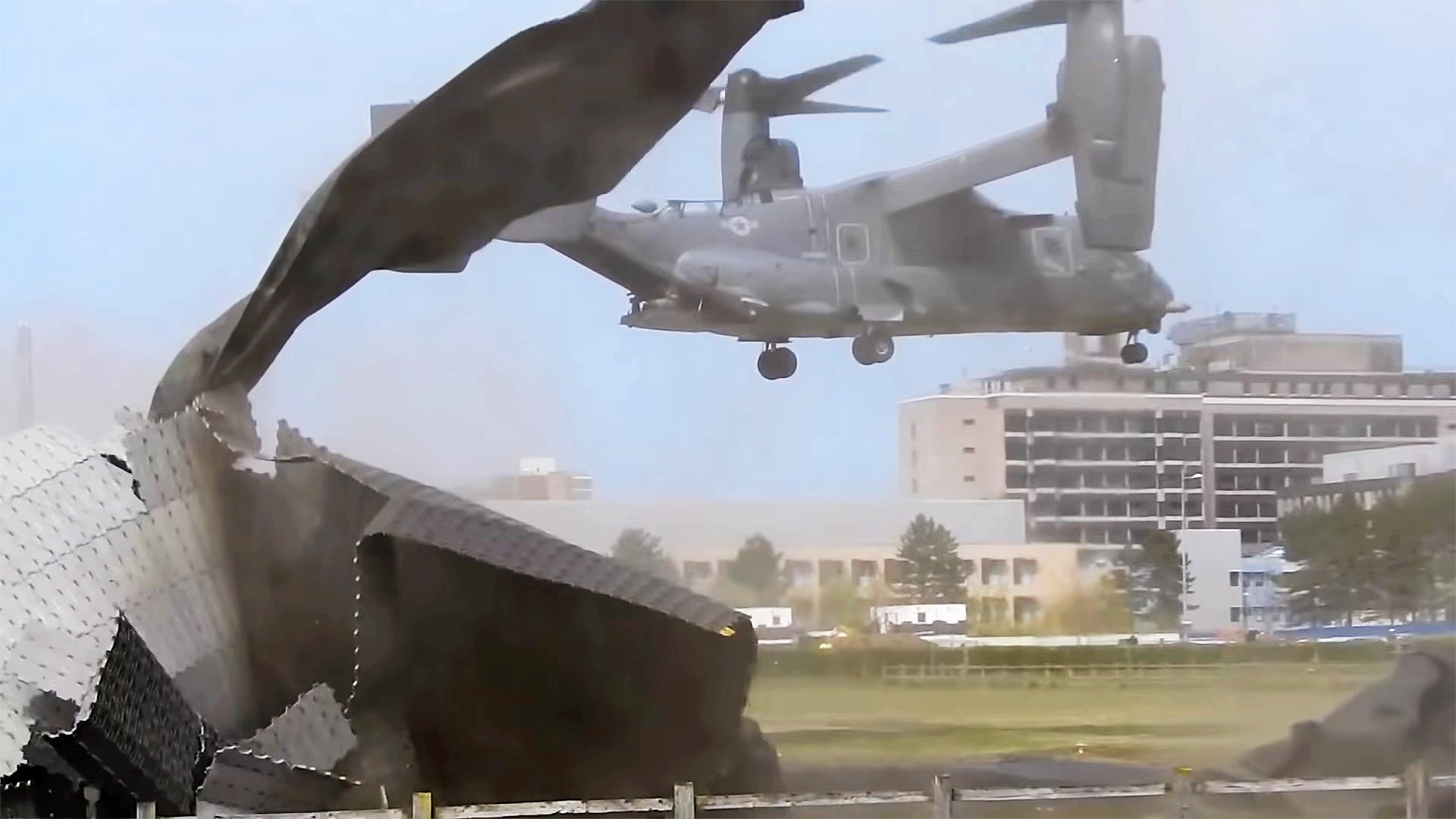A hospital in the United Kingdom is currently unable to receive patients directly via air ambulance helicopters after the powerful downwash from a U.S. Air Force CV-22B Osprey tiltrotor destroyed its helipad. The Osprey had touched down at Addenbrooke’s Hospital in Cambridge yesterday as part of a training exercise.
Spokespersons for the Air Force, Cambridge University Hospitals, which includes Addenbrooke’s, and East Anglian Air Ambulance (EAAA), one of a number of air ambulance services that regularly flies to this particular hospital, all confirmed the incident, which occurred on April 21, 2021, and did not cause any injuries. A video, seen below, has appeared online showing the CV-22B landing vertically, without incident, on the grass next to Addenbrooke’s helipad, which consisted of rubber matting. It was during takeoff that downward force from the aircraft’s rotors sent the matting, along with other debris, flying.

“The area was surveyed according to our policies and procedures and some damage did occur,” a spokesperson for the Air Force’s 48th Fighter Wing at RAF Mildenhall, told ITV News. “We are taking steps to rectify as soon as possible.”
RAF Mildenhall is also home to the Air Force’s 352nd Special Operations Wing. That Wing includes the 7th Special Operations Squadron, which is equipped with the CV-22B.
“While our normal helipad is being repaired air ambulances will temporarily land at nearby Cambridge City Airport and patients are then transferred to the hospital in road ambulances with critical care staff on board, meaning we can continue to see and treat them as normal,” a Cambridge University Hospitals spokesperson also told ITV.
“Due to an incident at the Cambridge University Hospitals helipad involving a military aircraft on Wednesday 21 April the helipad [at Addenbrooke’s] is temporarily unavailable to air ambulances,” Dr. Victor Inyang, EAAA’s Medical Director, added in a statement to that outlet. “It will be possible for the EAAA helipad [at Cambridge City Airport] to be used as an alternative landing site during this time and have patients transferred to Addenbrooke’s from there by land ambulance.”


Despite the statements from Cambridge University Hospitals and EAAA, the loss of the helipad at Addenbrooke’s could be cause for concern. Medical professionals often refer to the “golden hour,” the first 60 minutes after someone experiences a traumatic and potentially life-threatening episode of some kind, during which there is the best chance to save, as well as avoid any serious complications. While there is an ongoing debate about the exact length of this treatment window, not being able to fly air ambulances directly to the hospital can only add time before a critically injured patient begins receiving care in an actual hospital, at least to some degree.
“Addenbrooke’s is the major trauma center for the region, therefore quick and efficient transfer of critically ill or injured patients to the hospital is vital,” EAAA Medical Director Dr. Inyang noted.
Plane spotters on the ground during the incident were also worried that the flying debris could have damaged the Osprey or hit bystanders on the ground. These are very real concerns, as The War Zone
explored in depth as part of our reporting regarding the misuse of U.S. Army National Guard helicopters to fly very low over protesters in Washington, D.C., last year, something you can read about in more detail here.
“I saw debris flying up in the air, my biggest fear was the helicopter. The worry was if the debris went above the roter [sic] it could have damaged the aircraft or, even worse, the people,” Elliot Langran, a plane spotter who witnessed the incident, told ITV. “I’ve been all over the place across the world, but I’ve never seen anything like this.”
This is, however, not the first time an Osprey has been involved in a similar incident. A U.S. Marine Corps MV-22B Osprey injured 10 people during an event on Memorial Day in 2010 in Clove Lakes Park on Staten Island in New York City, when its downwash sent tree branches and other debris flying into a crowd as it came in to land.


The potential risks posed by the immense downward force from the Osprey’s rotors during vertical takeoffs and landings are well established at this point. Marine MV-22s were notably restricted in where they could operate from during disaster relief operations in Nepal following a massive earthquake in that country in 2015 in part due to concerns that their downwash could knock down already structurally weakened buildings.
The heat from the downward-facing engine exhausts when Ospreys operate in their vertical takeoff and landing mode also requires that landing areas, both on land and on ships, be strengthened to mitigate wear and tear. This does not appear to have been an immediate factor in this incident, though.
Thankfully in this particular incident, no one was injured. Hopefully, Addenbrooke’s Hospital’s helipad will be back in operation soon.
Contact the author: joe@thedrive.com
